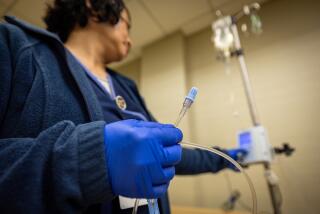Computer File for Fighting Cancer : Physician’s Data Query Provides Update on Treatments
WASHINGTON — Richard Bloch--he’s the R in H & R Block--was diagnosed as having lung cancer some years ago and was told by his physician that there wasn’t anything to be done.
But because he is rich and because he is smart--and because he was determined not to give up--he was able to get to one of the top cancer research centers in the world, M. D. Anderson Hospital and Tumor Institute in Houston, where specialists found that his was a type of tumor that would respond favorably to a course of treatment under investigation at that time at that center.
“In effect,” says Dr. Daniel Masys of the National Cancer Institute’s Physician’s Data Query (PDQ), “he was cured by experimental therapy.”
“The message,” says Masys, “was not lost on Richard Bloch. He realized that if that had happened to him, it must have happened to others.”
And that, so the legend goes, was how the National Cancer Institute’s computerized instant-update on cancer treatment got started.
Initiated Concept
In effect, Physician’s Data Query is a peer-review computerized medical journal of oncology. Bloch initiated the concept and helped finance the project. The PDQ computer, in fact, is housed in the R. A. Bloch Building, just off the campus of the National Institutes of Health.
According to Masys, chief of one of the Physician’s Data Query’s three National Cancer Institute parent branches, the new computer program will provide up-to-the-minute capsulizations of the latest published research on particular cancers. It will also be able to broadcast “new therapies and treatments not yet in the medical literature.”
As an example, he cited a new hormonal treatment for prostate cancer. The new agent, called leuprolide, “is not proven 100%,” says Masys, “but this one appears to have the ability to make the tumor shrink down in patients who have failed all the other agents available and have become resistant to them.”
“It doesn’t cure,” said Masys, “but it can improve the quality of life and prolong survival, buy additional time for the patient.
“The early results are so dramatic and so promising that even though it is still investigational, PDQ could tell a practitioner at his wits’ end where a patient could receive this treatment.
“Of course, you can’t just go and write a prescription for it yet, but knowing where it is being used could help get a patient enrolled in one of the tests.”
New Chemotherapy
Another example, described by National Cancer Institute director Vincent De Vita at PDQ’s formal unveiling last January, is that of a new chemotherapy for a late stage of Hodgkin’s disease--what the specialists call stage 3A--formerly treatable only by radiation.
Physician’s Data Query is unique, De Vita said. No other illness or disorder has a computer file so comprehensive and quickly accessed.
In a television presentation broadcast by satellite to 200 hospitals during the Physician’s Data Query press presentation on Jan. 31, Daniel Masys demonstrated how a general practitioner, faced with a patient with testicular cancer, could make use of PDQ. Once considered a virtual death sentence, up-to-date treatments make it almost entirely curable today. A general practitioner who might see only one or two cases of testicular cancer in several years might be unaware of the new successful therapies.
De Vita estimated that Physician’s Data Query could save thousands of lives because “cancer is more than a hundred diseases, each with its own set of problems. Because decisions are often complex and because it is difficult to keep up with the rapid advances already made in cancer treatment, PDQ provides an invaluable resource for physicians.”
Board Approval Needed
Before a therapy such as leuprolide, for example, can go onto the PDQ data base, it must be approved by an editorial board of 21 physicians. This board and an advisory group of 72 other specialists will review and discuss the state-of-the-art treatment advances that are deemed important enough or close enough to being confirmed to get into the computer, even though they may be months away from the appropriate medical journals.
But advances are only one part of the Physician’s Data Query “menu.” Other parts permit subscribing physicians and other health professionals to get information on treatment studies--experimental drugs or other investigational techniques--that may be under way in or near their own communities, or to gain access to 10,000 cancer specialists and 2,000 institutions with special cancer programs around the country. (The institutions are indexed geographically so, again, one offering an appropriate program may be found relatively near to a patient’s home town. Or a nearby specialist may be found as a consultant.)
It is that list of 10,000 specialists, however, which has caused some consternation among members of the medical community.
The American Medical Assn., for example, is opposing Physician’s Data Query principally on the grounds that the list is seriously flawed.
An official of the AMA who asked not to be identified put it this way:
“Technically PDQ provides information of interest on cancer-research treatments. But the list of physicians are members of societies and institutions who are dedicating the principal part of their practice to the treatment of cancer patients. It excludes general practitioners who also can provide state-of-the-art treatment. And conversely, some of the research oncologists on the list may be involved in very narrow research but not be able to provide overall treatment.
“In other words, some of those on the list don’t treat patients, and some who treat patients are not on the list.”
According to the AMA spokesman, the organization is also concerned that because Physician’s Data Query is a government project, widely accessible and available through the National Library of Medicine’s MEDLARS data base, it might be accessible to more than just health professionals--to, for example, patients.
Patient Access Unlikely
However, even those who participated in Physician’s Data Query’s creation think patient access is unlikely. As one member of the National Cancer Advisory Board noted, “It’s going to be a long time before Joe Schmo on the corner will be able to get anything out of it. (But) it is what you definitely call ‘user unfriendly.’ After all, how many doctors are computerniks?”
The National Cancer Institute hopes almost all doctors will become at least computer competent, even if it takes some persuading from their patients. It has already negotiated with the commercial physician’s computer network Colleague and hopes to get other data bases to offer Physician’s Data Query.
Physicians subscribing to MEDLARS have had access to PDQ since March, 1984. A physician needs only a home computer and a modem--a telephone hookup--to reach Physician’s Data Query once he is assigned a code. Or he may arrange occasional access with a nearby library or medical school, 2,000 of which are subscribers.






